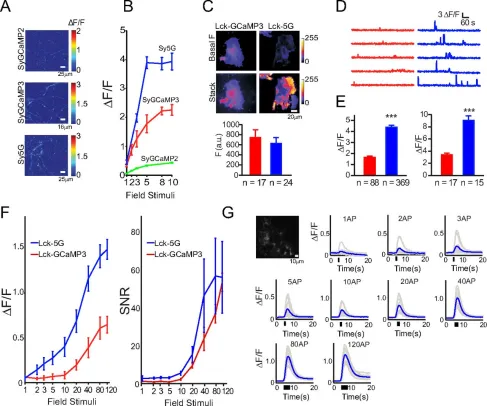The paper on G-CaMP5 has been published.
Optimization of a GCaMP Calcium Indicator for Neural Activity Imaging
Genetically encoded calcium indicators (GECIs) are powerful tools for systems neuroscience. Recent efforts in protein engineering have significantly increased the performance of GECIs. The state-of-the art single-wavelength GECI, GCaMP3, has been deployed in a number of model organisms and can reliably detect three or more action potentials in short bursts in several systems in vivo. Through protein structure determination, targeted mutagenesis, high-throughput screening, and a battery of in vitro assays, we have increased the dynamic range of GCaMP3 by severalfold, creating a family of “GCaMP5” sensors. We tested GCaMP5s in several systems: cultured neurons and astrocytes, mouse retina, and in vivo in Caenorhabditischemosensory neurons, Drosophila larval neuromuscular junction and adult antennal lobe, zebrafish retina and tectum, and mouse visual cortex. Signal-to-noise ratio was improved by at least 2- to 3-fold. In the visual cortex, two GCaMP5 variants detected twice as many visual stimulus-responsive cells as GCaMP3. By combining in vivoimaging with electrophysiology we show that GCaMP5 fluorescence provides a more reliable measure of neuronal activity than its predecessor GCaMP3. GCaMP5 allows more sensitive detection of neural activity in vivo and may find widespread applications for cellular imaging in general.
This is the best fully-characterized GECI available, but publication of the paper was repeatedly delayed. Why? Because reviewers viewed it as ‘too incremental’ of an upgrade, and not worth publishing in a prominent journal (no, I’m not talking Nature or Science level) when the plasmids are already available.
A friendly suggestion for authors and future GCaMP6+ reviewers : You can’t have it both ways. If you want access to the best molecular tools before publication (GCaMP5 has been available for over a YEAR), you cannot turn around and say its not worth publishing because you already have the plasmid. Multiple post-docs spent years of their lives developing and carefully testing this tool. They deserve a quality publication for their efforts. Furthermore, the rigorous performance data collected NEEDS to be available to current and future users. Finally, there is no doubt that this will be a highly cited and viewed paper in whatever journal were to publish it. Our GCaMP3 paper already has 182 citations in less than 3 years, this may do even better.

agreed! the refs mustve been non-geci-using doofuses.
[…] Hires has a post up on Brainwindows on the paper and its publication. He writes, “…the paper was repeatedly delayed. Why? Because reviewers viewed it as […]